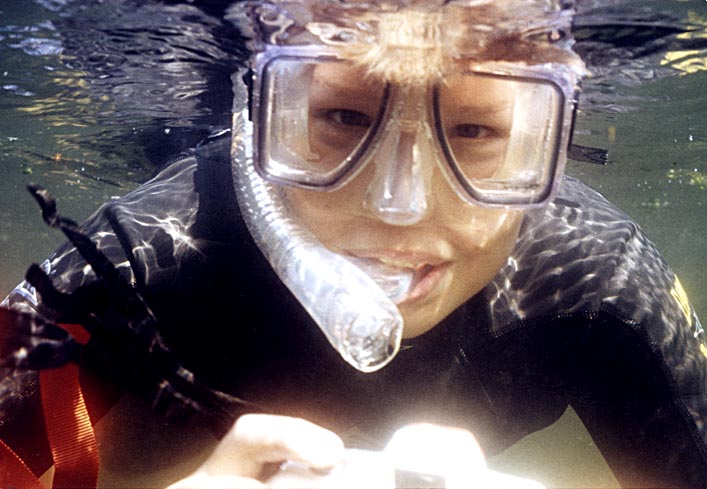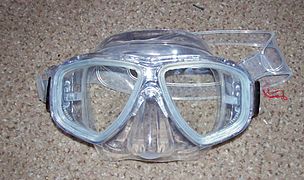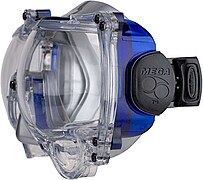
Diving mask
A diving mask (also half mask, dive mask or scuba mask) is an item of diving equipment that allows underwater divers, including scuba divers, free-divers, and snorkelers, to see clearly underwater.[1][2] Surface supplied divers usually use a full face mask or diving helmet, but in some systems the half mask may be used.[2] When the human eye is in direct contact with water as opposed to air, its normal environment, light entering the eye is refracted by a different angle and the eye is unable to focus the light on the retina. By providing an air space in front of the eyes, the eye is able to focus nearly normally. The shape of the air space in the mask slightly affects the ability to focus. Corrective lenses can be fitted to the inside surface of the viewport or contact lenses may be worn inside the mask to allow normal vision for people with focusing defects.
For the full-face version, see Full-face diving mask.Other names
- Half mask
- Scuba mask
- Free-diving mask
- Snorkelling mask
Provides clear underwater vision for divers
When the diver descends, the ambient pressure rises, and it becomes necessary to equalise the pressure inside the mask with the external ambient pressure to avoid the barotrauma known as mask squeeze. This is done by allowing sufficient air to flow out through the nose into the mask to relieve the pressure difference, which requires the nose to be included in the airspace of the mask. Equalisation during ascent is automatic as excess air inside the mask easily leaks out past the seal.
A wide range of viewport shapes and internal volumes are available, and each design will generally fit some shapes of face better than others. A good comfortable fit and a reliable seal around the edges of the rubber skirt is important to the correct function of the mask. National and international standards relating to diving masks provide a means of ensuring that they are manufactured to a suitable quality.
Fit[edit]
A mask is considered to fit well when it seals comfortably and effectively all round the skirt, and provides a good field of vision, without pressing on the nose or forehead while in use underwater. A low internal volume is considered desirable by freedivers, as less breath is wasted to equalise, and by scuba divers, as there is less tendency to press up under the nose due to buoyancy, which becomes uncomfortable quite quickly.[21]
Divers may test whether a mask is a good fit by placing it on their face, without using the straps, and gently inhaling through their nose. If the mask stays on without any help this indicates that no air is being drawn in and that the skirt is in sufficient contact with the facial skin all the way round the mask. Optimum sealing requires that hair strands do not cross under the edge of the seal, as they can provide a path for water to leak into the mask. This is more a problem with the forehead hairline than with lower facial hair, as water from the top tends to run into the eyes, while water pooling at the bottom is easily purged by exhaling a small volume of air through the nose. Most bearded divers learn to manage the slight leakage without difficulty, inconvenience, or greasing the moustache. Other factors affecting a comfortable fit are sufficient space for the nose in the nose pocket, no contact between the rigid mask frame and the bridge of the nose, and no excessive pressure on the forehead. There should also be sufficient space between the mask lenses and the face that the eyelashes do not contact the glass noticeably when blinking.[22]
Early diving masks were made with a single pane of glass or transparent plastic, usually elliptical, but sometimes circular or approximately rectangular or triangular with rounded sides and corners.[25] These masks have indentations in the skirt at the bottom on either side of the nose, into which the diver can insert a thumb and forefinger to pinch the nose, when performing a valsalva maneuver to clear their ears. This design was improved by bringing the window closer to the face, reducing the volume of air inside the mask, thus making mask clearing easier. The window has a cutout to fit around the nose, which is covered by the rubber or silicone material of the skirt. This facilitates pinching the nose when ear-clearing.[21]
A further development is the mask with two windows, one for each eye. It can have the windows closer to the face than the one-window type, and therefore contain less internal volume for the diver to clear or equalise, and a lower buoyancy. These types are often called a "low-volume mask".[21] Participants in the sport of underwater hockey are required to use twin-lens masks of this type for their own safety – the sport uses a heavy lead puck similar to an ice hockey puck, but skillful players can flick the puck a considerable height off the bottom when making passes which leads to the possibility of accidental puck contact with other players. Should a puck hit the lens of a single-lens mask it may break the glass and pass through the aperture to hit the face and eyes, but with a twin-lens mask, though the glass may break, the frame will prevent the passage of the puck any further.[26]
Recent innovations have produced more complex designs, intended to provide extra features:
There are other types of equipment for underwater vision enhancement:




